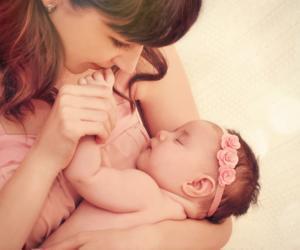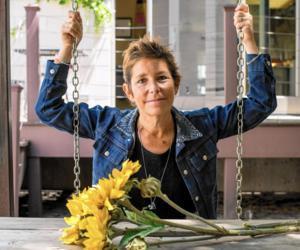Ovarian Cancer: The Cliché About Cancer That’s True

Last June, 24-year-old Dani Strumeier, a tax accountant at PwC, began to experience pain in her lower abdomen, but she brushed off going to the hospital because she knew that there would be needles there. She could not have blood drawn from her body without throwing up or passing out. Fortunately, a close friend of hers (who would later become her boyfriend) talked her through her fear and persuaded her to go to the emergency room.
Initially, doctors told Dani that she had a ruptured ovarian cyst and that she would require immediate surgery in order to stop the hemorrhaging of blood into her abdomen. They told her that there would be an oncologist in the room during her surgery to help assess the cyst and determine whether it is cancerous, but that she should not worry because she was ‘too young to have cancer’. After her surgery, the doctors reassured her once again that it was not cancer. However, in mid-July, Dani found herself in an oncologist’s office at Memorial Sloan Kettering Cancer Center, anxiously waiting to hear about a treatment plan for what turned out to be a diagnosis of ovarian germ cell cancer. Ovarian germ cell cancer is a very rare type of ovarian cancer that originates in the egg cell. Less than 2% of all types of ovarian cancers are germ cell.
How her diagnoses changed everything
For Dani, her 24th year was supposed to be a time of self-discovery. For months, she dismissed the pain that she was experiencing in her abdomen from time to time and threw herself into her work. In May, she found out that she was being promoted, but this was not even the best part about her life at the time. “I was also leaning into the people I cared most about, discovering new joys in the simplest of pleasures: grabbing margaritas with my friends after work, and spending as much time as possible with my niece,” she said.
“It’s cliché now to say that a cancer diagnosis has a way of changing everything, but that doesn’t make it any less true,” said Dani. Her oncologist never fully disclosed the severity of her diagnosis but she did acknowledge her fears and concerns. Dani was told that she would need to undergo surgery to remove her right ovary and fallopian tube, followed by aggressive chemotherapy sessions. Although Dani’s oncologist told her that treatment would be difficult on her both mentally and physically, the tumor was likely to be responsive to the treatment. “What she didn’t tell me was what, exactly, she meant by “aggressive” — mostly because how could she? The experience of cancer treatment is a lot like childbirth or Burning Man, which is to say it’s not something you can really explain to someone beforehand,” said Dani.
Her greatest fear was that the aggressive chemotherapy sessions would strip away her old self. However, first she would need to get over her fear of needles and blood. After four weeks of receiving self-injections by her boyfriend for an egg freeze, Dani’s fear of needles began to fade. “Right before I started treatment, I was asked to participate in a study called Make-an-Impact, which is a research project at Memorial Sloan Kettering that collects genomic data from patients so doctors and scientists can learn more about germ cell tumors, and other specific types of rare cancers,” she said. Although a blood test was required, thanks to her newfound courage, Dani happily accepted the opportunity to participate in the study and make a difference.
Coping with the loss of her signature feature
Afterwards came her greatest fear: the fear that she would take a look in the mirror after undergoing 9 weeks of chemotherapy and not be able to recognize herself. “Before I was diagnosed, I had long, jet black hair. It was the thing that first drew Nick to me, and something I’ve always loved about myself. My black hair had always been a defining staple of mine, ever since I was 13 and got my first grey and I started dyeing it,” said Dani. During her second week of chemotherapy, she began to experience tingling on her scalp and she knew that the days with her long black hair were numbered. “And then the day finally came: I woke up to find my pillow covered in black hair. Now when I ran my fingers through my hair, instead of seeing one or two hairs come out into my fingers, I’d have a handful” she said. During one of these moments, Dani realized that she could not just sit back and do nothing. Within a few hours, her brother arrived with a buzzer and her boyfriend Nick started to shave her head. “The first time I looked in the mirror with my buzz cut, the fear immediately melted away. I looked very different, yes, but the core of who I am was still there,” she said.
Her fears brought to life
As the weeks of chemotherapy continued onward, Dani could barely get out of bed. She was supposed to undergo 9 weeks of chemotherapy sessions, but she ended up undergoing 7 because of the drugs’ severe effects on her lungs. “By the end, the fatigue ran so deep, like every single one of my body’s cells was operating in slow motion, that I felt transformed. My eyelids felt like they had 40-pound weights dragging them down, while my nausea and anxiety kept me from sleeping,” said Dani. She looked at herself in the mirror and saw cancer, not herself. She was exhausted physically, mentally, and emotionally – just as she had feared she would be.
Cycle for Survival
Yet, instead of letting this get her down, Dani found joy starting a Cycle for Survival team. Cycle for Survival is a movement to beat rare cancers. Indoor team cycling events take place in January, February, and March. Even though the date of the cycling event was not for another six months, Dani found the idea of having something to look forward to in the future to be encouraging and exciting during her treatment and recovery. “I felt so proud every time another donation came through – especially because the Make-an-Impact research project I participated in is funded by Cycle for Survival, so I know the funding will truly help others like me in the future,” she said.
Once her chemotherapy sessions were over, Dani stepped onto a treadmill and slowly but surely, she began to run a mile and a half after 40 minutes. As the date for the Cycle for Survival event finally arrived, Dani was thrilled to ride along with 100 members of her family and friends to help raise money for rare cancer research by Memorial Sloan Kettering. She set a goal for herself to cycle for about 25 minutes, but as soon as she got on the bike, she felt an immense wave of energy and support overcome her. Dani ended up riding for the entire 50 minutes.
Learning that change is not always bad
In the end, Dani’s fear that the cancer experience would completely change her turned out to be true. However, she learned that being changed by something does not necessarily always have to be a bad thing. “While it’s true that by the end of my treatment, I was beat up, I was also transformed. I had learned so much about myself and how strong I am, that love and family are most important, and that light always finds its way of peeking through. In the end, 2017 really was a year of self-discovery,” said Dani.
Reference
https://www.refinery29.com/ovarian-germ-cell-cancer-cycle-for-survival-patient-story















